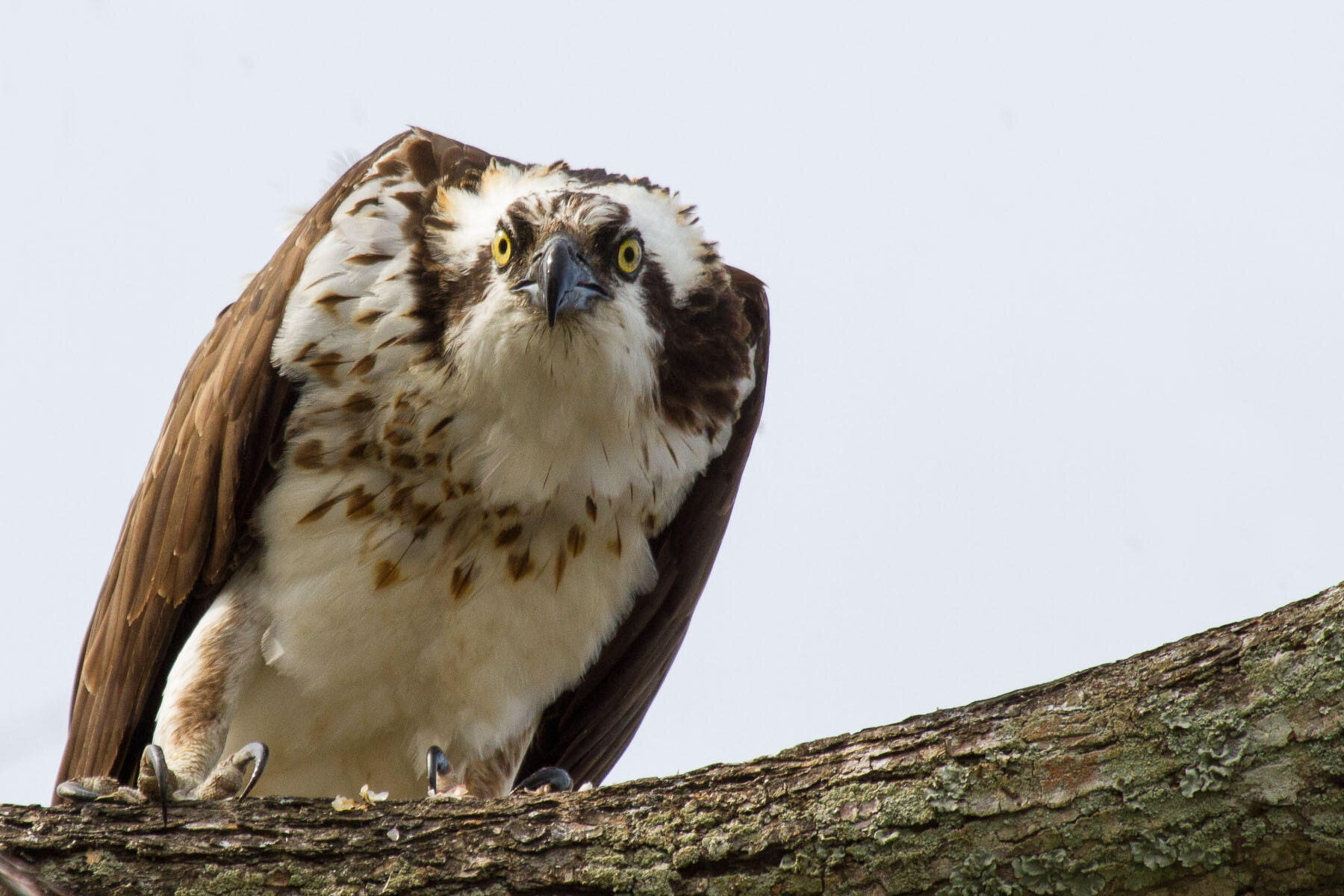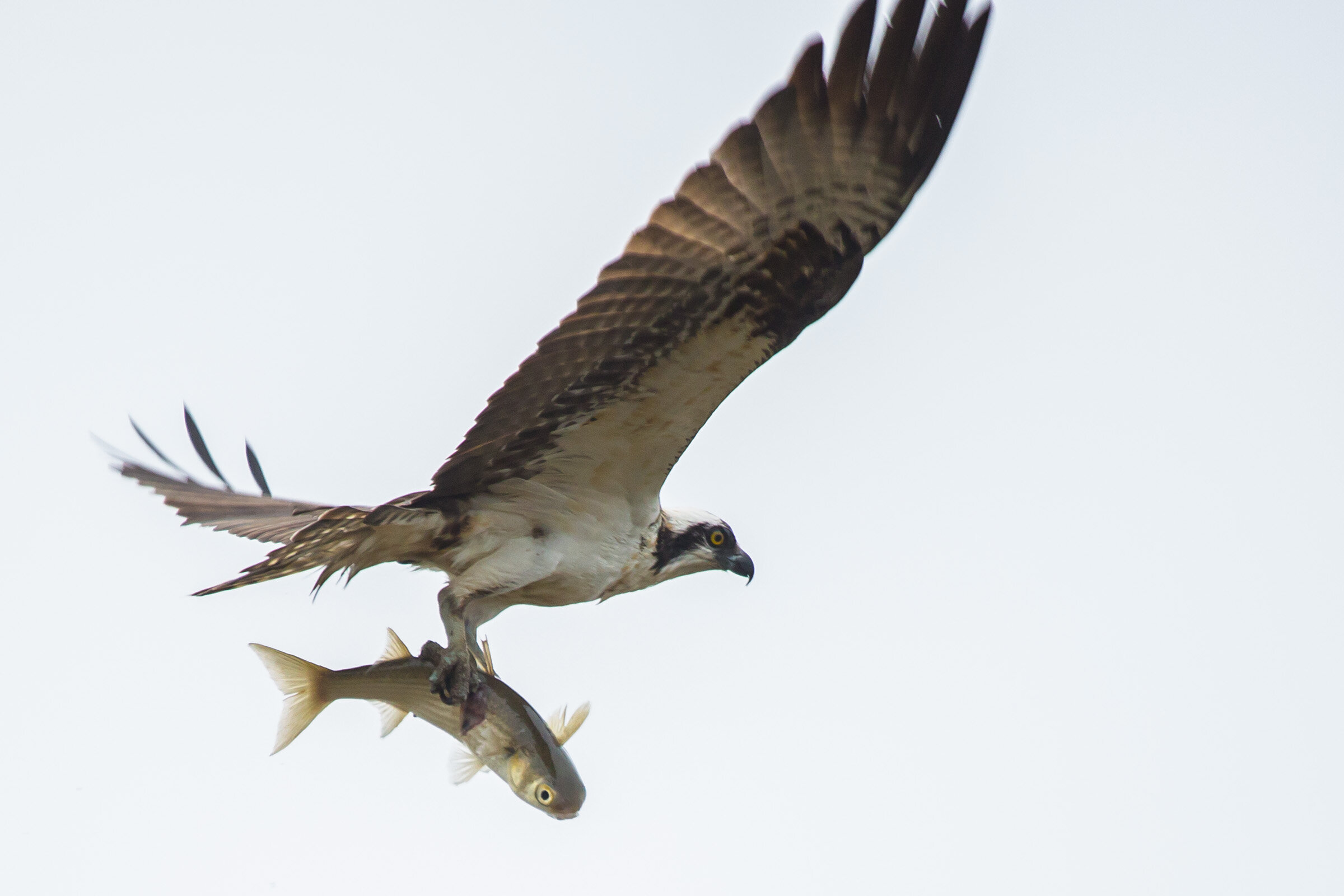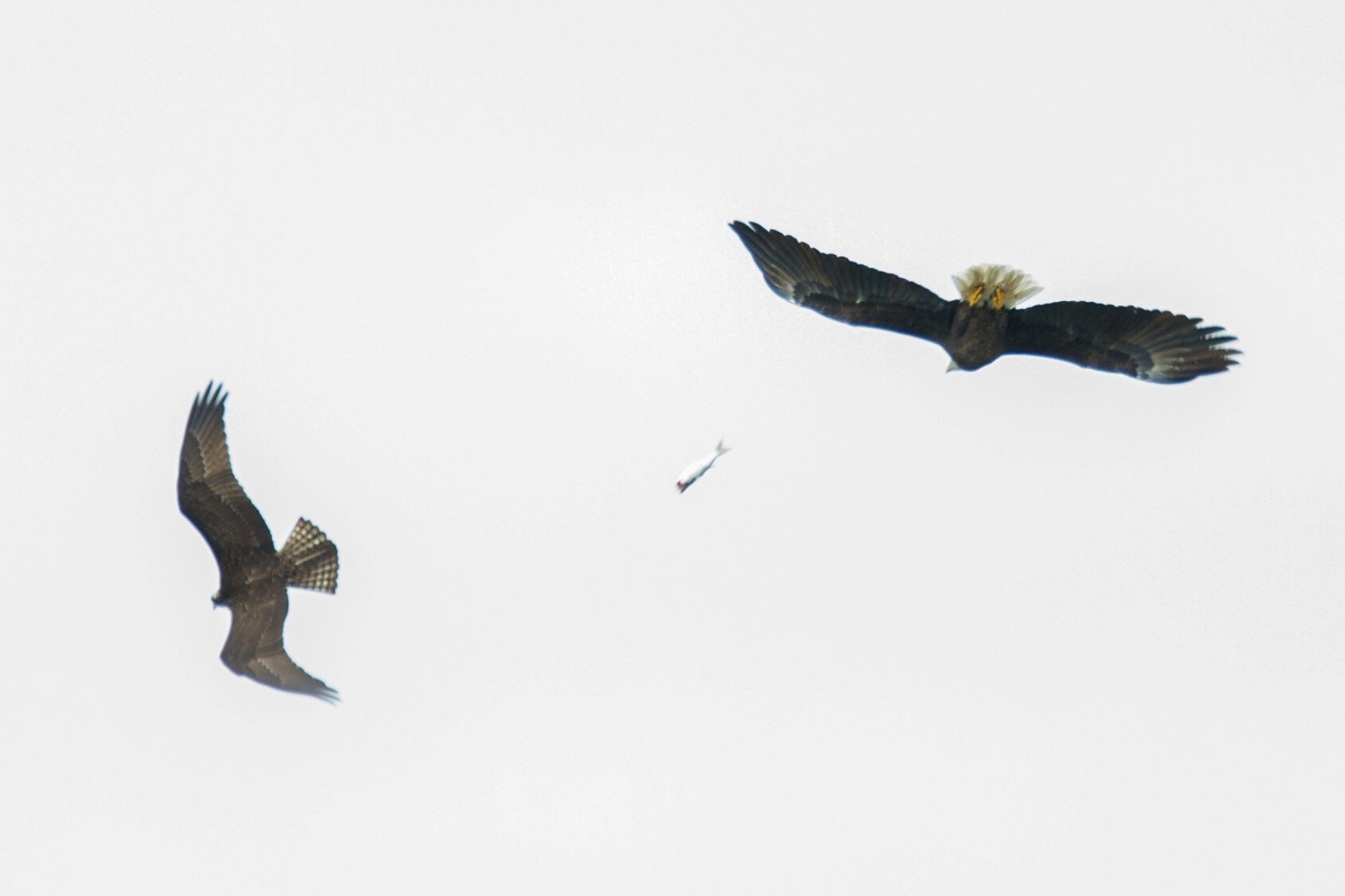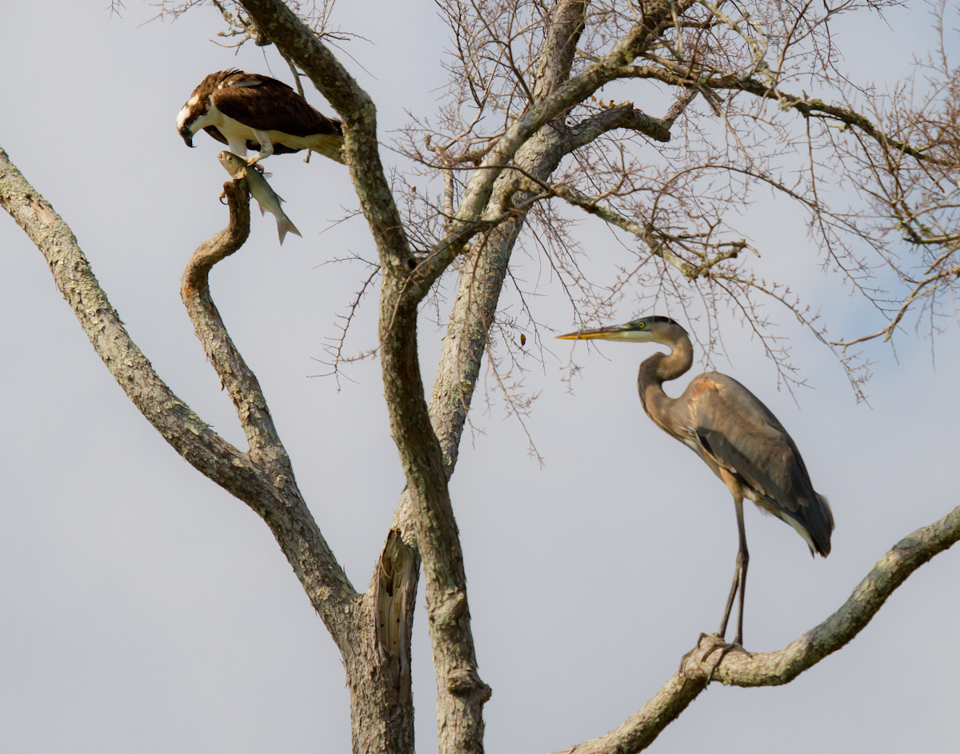Armand Bayou Osprey
Written by Mark Kramer
Female Osprey wear a necklace of brown feathers at the base of their neck | Photo by Gary Seloff
This marks the time on the calendar that I begin to watch the sky around Armand Bayou. The weeks of late September mark the return of two iconic birds of prey back to the Texas coast. Osprey return to coastal Texas after nesting elsewhere. They return at an ideal time when bayou waters are at their peak of productivity. All summer, juvenile marine fishes have been hiding, feeding, and growing in the nursery areas provided by lush green tidal marsh along the shoreline. Osprey eat only fish. Now these fishes have reached optimal size to begin their migration. The average arrival of our first Fall cool front occurs during the last few weeks of September too. Dropping water temperatures and shortening day-length are two key signals which trigger the migration of marine organisms back to the open Bay and Gulf. Osprey return to the bayou to capitalize on the banquet. The nesting pair of American Bald Eagles also return. For the past two years, my first sighting of the Eagle has occurred on September eleventh. That also makes for an easy memory trick to associate the return of the National Symbol with 9-11.
Striped Mullet are the primary prey in Armand Bayou | Photo by Gary Seloff
For the osprey (Pandion haliaetus) of Armand Bayou, their diet is focused primarily on one species. Striped mullet, which are abundant and spend much of their life near the surface of the water. They are perfectly sized prey, averaging about a pound in size. Some mullet remain in the Bayou all year, which is critical for Osprey that require a fish per day during the cold of winter.
Osprey perform a spectacular aerial display, diving head-first into the water from great height | Photo by Gary Seloff
To see an Osprey (also called the Fish Hawk) dive and catch a fish is always the greatest thrill of any trip on the water. The birds soar at 60-80 feet above the water in search of a meal, always hovering with their head into the wind. This allows the air to travel over their wings and requires less effort during the focused part of the hunt. If the wind is calm, Osprey have the ability to “helicopter” in one place. Moving their wings in a “figure eight” allows them to “scull” the air similar to the same motion used by paddlers.
Impressive | Photo by Gary Seloff
Once the bird is locked on to their prey, they fold their wings and dive head-first towards the water. At the very last instant, they thrust their talons ahead to hit the target. Often, they go completely underwater in the process of the dive creating a huge splash.
Osprey talons are specially adapted to carry fish | Photo by Gary Seloff
Osprey talons are shaped differently than most other birds of prey. Upon making contact with a fish, one of the talons swivels for a better grip. This places two talons on each side of the fish’s body. The inner pads of each toe are covered with rough spicules which further enhance the grip on a slippery fish.
Heavy Lifting | Photo by Gary Seloff
If they are successful, the real work begins. After being totally submerged in the dive, Osprey must lift a third of their body weight out of the water and carry it to a feeding perch. That’s a tall order for a bird which only weighs three pounds.
Ospreys have unusually flexible elbows which aids the lift | Photo by Gary Seloff
Osprey are capable of accomplishing the task thanks to several adaptations and a fierce spirit. Osprey wings are built to bend at the shoulder as most bird wings do. However, they also have an unusual range of motion and strength at the bend in the elbow. This enables the birds to gain extra power and lift as they struggle to leave the water with wet feathers and their catch.
Once airborne, birds always fly with the fish’s head pointed forward to streamline the aerodynamics of flight | Photo by Gary Seloff
Osprey are one of the most vocal birds of prey in the world | Photo by Gary Seloff
Unlike many other birds of prey, Osprey are quite tolerant of coexisting with other Osprey. In fact, it’s common for a bird to fly along the bayou and have every Osprey perched along the shoreline singing its characteristic call as it flies past. If you listen, the flying Osprey will trigger a series of calls from every other Osprey as the birds continue on their way. It’s a social chorus line of greeting each other.
Osprey have several distinct calls. The most common is used when other Osprey fly past or when they are lounging and announcing their presence. However, the birds also have a distinct call which is almost frantic and used when an Eagle is approaching. It almost sounds as if the bird’s tail is on fire. It’s a great auditory que to look to the sky for a view of one of the most spectacular aerial displays in North America.
Eagles are kleptoparasites! | Photo by Gary Seloff
Both Osprey and eagles return to the bayou at roughly the same time in September. Eagles are capable of catching fish but prefer to rob fish from the Osprey. I believe that a major factor in eagles choosing to return to and nest on Armand Bayou is the large number of Osprey which eagles can steal from. Some of the most memorable pontoon tours occur when these two birds of prey conduct aerial combat over a meal.
Great Blue Herons eat mullet too, but not this time | Photo by Gary Seloff
Osprey have favorite perches that they return to every day for dining or just to survey their domain. These are tree limbs of just the right diameter for the size of their talon, with good texture and preferably a good view.
Osprey are slow eaters and take small bites | Photo by Gary Seloff
Eating fish can be messy. Osprey often skim the water’s surface dragging their talons in an effort to remove blood and slime | Photo by Gary Seloff
I have had the pleasure of watching Osprey perch and dine from my living room window for many years. They always begin with the head which minimizes further flapping of the fish. The Osprey bill is small and only capable of tearing small pieces of fish flesh, about the size of a thimble. It typically takes over an hour to finish the meal.
Osprey generally don’t nest in Texas | Photo by Gary Seloff
Osprey return to Armand Bayou after nesting elsewhere in the U.S. They nest in Gulf states east of the Mississippi River, throughout both coasts of Florida, and all the way up the east coast to Maine. They also nest in the Pacific Northwest. I got a phone call several years ago from a long lens photographer who had taken a picture of an Osprey which was perched on a tree along the bayou. His picture allowed him to the read the numbers on the band. He followed up with the U.S. Fish and Wildlife Service. It turns out that the bird was banded the previous year in Yellowstone National Park. I immediately thought, now that’s the life for me, fishing summers in Yellowstone and winters on Armand Bayou.
It’s not totally accurate to say Osprey don’t nest in Texas. The USFWS Breeding Bird Survey lists eleven known nests in Texas. Eleven nests are not many for an area the size of Texas. In 1996, ABNC partnered with Houston Lighting & Power to install artificial osprey nesting platforms on top of old telephone poles. These structures have been used with good success throughout the bird’s more traditional nesting range. HL&P set the poles and placed the nest platforms (built by ABNC) on top with their equipment. We even placed some nesting twigs on each platform as “chum”. Other raptors stole the twigs. After 15 years of no use, we removed all six of the nesting platforms.
This nest in Horsepen Bayou never produced young and was only used once | Photo by Gary Seloff
Osprey are very tolerant of humans where they do nest. In Florida, I have seen Osprey nest on streetlights in the center of the freeway and on TV antennae beside homes. There was a brief attempt at nesting in Horsepen Bayou several years ago. I believe that young birds were practicing, playing like children at first love. The nest was very unstable and poorly constructed. No young were produced from the nest. The nest was abandoned the following year and never reoccupied.
Osprey are one of several bird species whose population declined steeply during the 1960’s and 1970’s. The insecticide DDT was used on crops and farmlands around the country. The toxic chemical washed downstream through the watershed accumulating in the fish that Osprey eat. As the chemical is absorbed, it’s passed from animal to animal and works its way up the food chain. This bioaccumulation often reaches its most serious impacts with apex predators at the top of the food web.
Such was the case for Osprey. DDT had the effect of compromising the bird’s ability to process calcium. Calcium is an important element in the production of bird eggshells. As the birds suffered these effects, their eggshells became very weak and fragile. When parent birds would sit on the egg for incubation, the eggs would crack. This lack of reproductive ability caused the Osprey’s population to steeply decline and nearly had the bird listed as an endangered species.
Dignitaries came specifically to view Armand Bayou Osprey | Photo from ABNC File Footage
During the 1980’s, Armand Bayou maintained a small population of Osprey even during the population lows of the era of DDT. Prince Phillip of England and renowned naturalist, Roger Tory Peterson, attended an Osprey tour from the Harris County Pontoon Tour Boat, the Hana G. It also allowed me to get his signature in my birding field guide written by him.
Photo by Gary Seloff
While Osprey were once threatened by the persistent pesticide, today their numbers have dramatically recovered. This is attributed in large part to the ban of this long-lived legacy pesticide as part of the Clean Water Act in 1972. Today, the birds have recovered and now occur on every continent except Antarctica. Armand Bayou populations have recovered as well. During a winter Pontoon Tour or Kayak Tour, its not unusual to have four Osprey in view at the same time.
We counted 23 Osprey on Armand Bayou during last year’s Christmas Bird Count. The Audubon Christmas Bird Count happens all around the country. Volunteers gather and count every bird seen which contributes valuable data regarding population trends in all bird populations. Traveling only three miles and counting 23 birds is an incredible number, and a testament to the health of the ecosystem and amount of fish which Osprey require. I wonder if there is anywhere else in America where a person can take a three-mile tour and see that many Osprey?

















